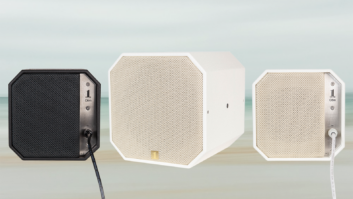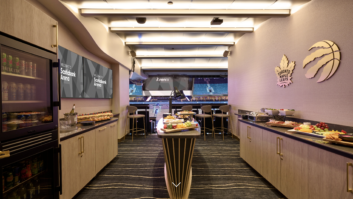
Matt Pruznick of our US sister title SCN spoke to HDMI Licensing Administrator’s CEO Rob Tobias and senior marketing director Brad Bramy about the new HDMI 2.1 specification.
At the end of November, the HDMI Forum released the HDMI 2.1 specification, the latest update to the ubiquitous connectivity standard. With a throughput of 48Gbps and the ability to handle 4K120, 8K60 and 10K video, plus a wealth of other signal enhancements, the announcement may have raised some concerns in the integration community – especially among those who have just upgraded infrastructures to the 2.0 standard. So we reached out to HDMI Licensing Administrator’s CEO Rob Tobias and senior marketing director Brad Bramy for insight into the new standard’s development, execution, and its implications for integrators.
What was the impetus behind the development of HDMI 2.1?
Rob Tobias: 2.0 came out in 2013, so it’s been over four years since the last specification came out. And during that time the approximately 90 companies that are part of the forum continually work on specification improvements for the industry and that covers the members, companies that make chips, make systems, cables, connectors, test equipment, and IP that goes into chips. They’re a who’s who of the consumer electronics industry, and they feel there’s a need to improve the HDMI specification to be available as the technology improvements are adopted across the industry.
How will the 48Gbps throughput be achieved? Are the cables going to require fibre or will they be copper with length limitations?
RT: It’ll be the second. The specification does define a new cable that will be capable of handling the 48 gigabits per second. It is specified as a copper cable, or as a non-optical cable. So there will be passive versions, and as you point out, the faster you go with passive cables, the shorter they become. So the cables won’t be as long as those that support the 18Gbps for the 2.0 specification. There is ability for the industry to do active copper cables, and your audience, some of them do very long distances, and there’s been a whole ecosystem of companies that have come up with ways to carry HDMI signalling, basically transform it either into optical or some other format, and carry it over things like Ethernet cable. And so I expect that ecosystem of companies to continue to evolve their solutions to carry these higher speeds.
The pro AV market… need to pay attention for new cabling when they move beyond 4K60
Rob Tobias
Which aspect of the standard – higher throughput or the ability to handle more sophisticated HDR and enhanced refresh rates – do you think will have the biggest impact?
RT: I think all of them will, over time. It’s similar to any HDMI spec: certain features are rolled out very quickly, and others take time because it requires hardware improvements. Not just from HDMI, but including the whole TV processing SoC and that whole pipeline. So things like dynamic HDR – that will be rapidly adopted across the ecosystem because that can be applied to existing 18-gigabit systems. In some cases, it could perhaps just be a software firmware update to existing products, but that’s at a manufacturer level. You mentioned the variable rate refresh, the game mode –Xbox One X is already out there talking about how they’re going to support that over HDMI. So certain products will take advantage of that feature quickly. We hear a lot of talk and excitement about the enhanced audio return [eARC] channel. So I think you’ll see that feature adopted fairly rapidly as well.
The higher speeds will come out and be associated with products that jump up and do 4K120 or 8K or beyond. And we’ve seen a lot of 8K demos throughout the past few years; some of the first commercial products are starting to be available. I was just at IFA this past fall, and Sharp announced that they’re going to sell 8K TVs and monitors and such. So that’s starting to roll out, but I think that will be just like the early days of 4K, where you had some very expensive products, not too large sales, but as years progressed, those prices rapidly declined and today 4K is pretty much mainstream.
Brad Bramy: As Rob said, it’s truly all of [the capabilities]. When I’m talking to people, what I find that most people are interested in are the combinations. So it’s not just that you can get dynamic HDR, but you can get dynamic HDR with the higher refresh rates and the higher resolution. But a lot of people aren’t really talking about those other – and maybe perceived as ‘secondary’ – features, but it’s the enhanced refresh rate features that are going to result in smoother and faster not just gaming, but viewing in general. So the variable refresh rate may apply more to gaming, but also apply to VR and other things like that. But the quick media switching benefits movies and video viewing, the quick frame transport reduces latency, and also there’s a separate auto low-latency mode.
So those things in combination – it’s not just HDR, but HDR with a smoother and more interactive experience. There’s a lot of lag right now like when you switch from one source to another and the screen is dark for a while – so all of that stuff is going to go away and everything is going to be much faster and much smoother. And I hope people focus on those and don’t see those as secondary features. I think that once those features start permeating the market it’s going to be really noticeable.
How do you expect the standard to influence hardware development?
RT: HDMI is part of a larger system, and like I said, all of the manufacturer vendors – the ecosystem from IP to chip, to subsystem to systems guys, to panel guys – all had a hand in this, and they’re all pushing the technology forward. So there will be hardware improvements such as 8K panels; 8K panels require drivers, require SoC that do the video processing, require an HDMI interface that can handle the higher bandwidth. So all of those things will move in lockstep as 8K moves from prototypes into mainstream products.
It’s not just HDR, but HDR with a smoother and more interactive experience
Brad Bramy
It also applies to other features: the eARC, because it now handles the higher performance audio formats, would require some hardware change. So there are chip companies out there working to enable that to be integrated into displays, soundbars, AVRs, and those sorts of things. Things like the variable rate refresh do require system changes as well: it requires a device to change its refresh rate. Today, TVs just set it at a certain refresh rate – maybe it’s playing an Ultra HD Blu-ray, 4K at 24 frames per second; it sets it refresh rate at 24 frames per second. And it might switch to a 1080p60 set-top box; it sets its refresh rate to 60Hz. But with a variable rate refresh, it has to on the fly. Maybe it goes down to 30 or 24, or below, or all the way up to 120, and it has to be able to do that on the fly. There are monitors out there that do that today. This whole variable rate refresh emerged from AMD and Nvidia with their G-Sync and FreeSync, that are tied to their gaming GPUs. So that will eventually make its way into TVs as well as the TV SoC makers continue to add new capabilities and features to their chips.
What do residential and pro AV integrators need to know about it now? When will installations start demanding it?
RT: Initially, some of these features like eARC and dynamic HDR – those type of capabilities can run over the existing HDMI high-speed cable infrastructure. And those will be some of the first features that will be rolled out into products. And we want to stress that, because I know that the pro AV market is starting to freak out, “Oh, I’ve got to rip out all of my cables, do all of that kind of stuff.” And it’s not necessarily so. Really, they need to pay attention for new cabling when they move beyond 4K60. So if they start to put in displays that are 4K120 over HDMI (they also need to understand the capabilities of the HDMI port). They could get a 4K TV where panel does 120Hz refresh but the HDMI port is still 4K60. It kind of goes back to the days of 1080p where they were first advertising 120Hz refresh, then 240Hz refresh, but that was the panel and not the HDMI port. However, when installers are putting in 8K displays, it’s very likely it’ll have the new HDMI 2.1 port running the 48 gig, and in that case, they will need to use the new cables.
When do you expect the cables to begin hitting the market?
RT: The cable guys are usually very fast. So I wouldn’t be surprised if early in 2018 you start to see some cable manufacturers start to talk about their cables coming to market.
BB: If you look at the FAQs on our website, there’s some good information there. And regarding the cables, people are probably going to be introducing some prototypes or introducing some things at CES. But if you look at the FAQs, it states very clearly that you can’t really bring something to market unless it’s in compliance with the specification and also the compliance test specification [CTS] and gets certified. So it depends on when that CTS is going to come out. But a cable has to be certified to be on the market, so that has to come first in terms of timing.
RT: Brad made a good point: the main spec has been released, and that gives HDMI adopters the opportunity to get the spec and start planning and building products. The CTS, the compliance test spec, is the one that is used and required for device manufacturers to test their product. So that’s not yet available. That will be available at some point in the first half of 2018. So before then, manufacturers are not able to promote that their products are 2.1 feature compliant. So there is this time before you’ll actually see officially tested and certified cables, and that won’t happen until the CTS is available.







